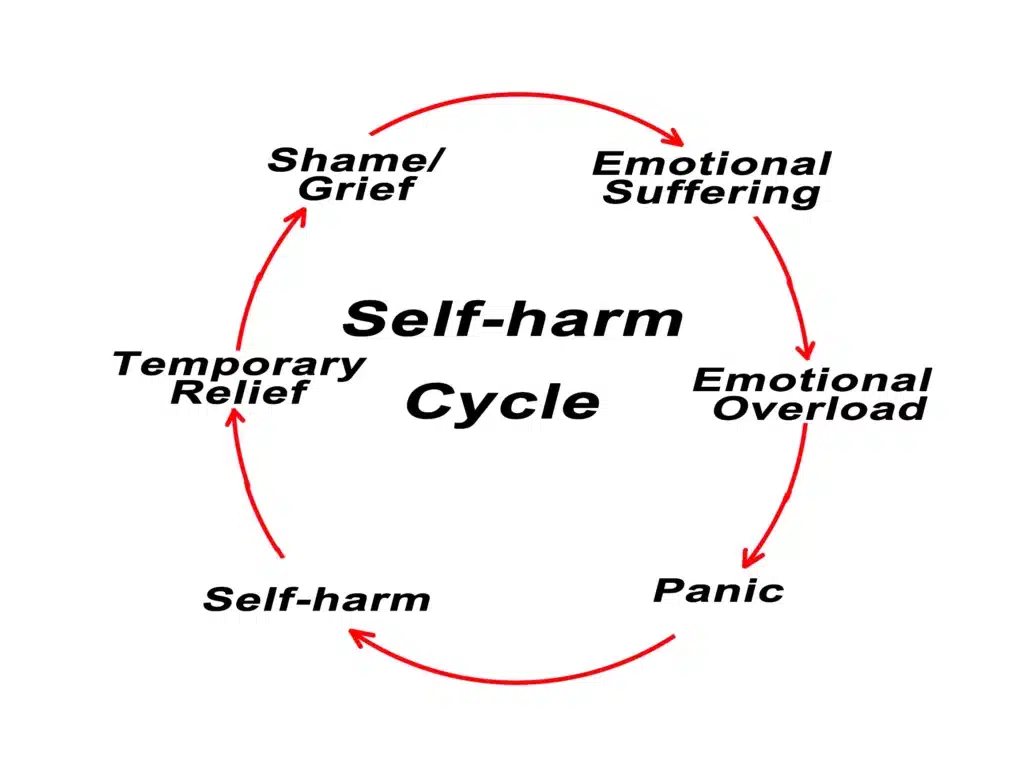Updated on October 6, 2023
What to Do When You Suspect Your Teenager is Cutting Themselves
Over one-third of teenagers in the U.S. reported engaging in cutting and self-harm behaviors before the pandemic. Today, experts estimate the percentage of adolescents who cut or harm themselves in other ways at nearly 50 percent.
However, studies investigating teen self-harm often report lower percentages because many teenagers won’t admit to cutting themselves.
A Parent’s Guide to Cutting and Self-harm Behaviors in Teens
A self-harm behavior (non-suicidal self-injury, or NSSI) is a behavior that causes a person to physically abuse themselves. Cutting is the most common type of self-injury behavior reported by teens. Kids who are “cutters” make superficial to moderately deep cuts on the wrist and thighs with razor blades, box cutters, or other sharp instruments.
Although the cuts are usually deep enough to cause bleeding, the amount of blood loss doesn’t usually require emergency treatment. When a cutting episode does send a teen to the emergency room, it will likely be reported as a suicide attempt by ER physicians.
The number of cuts to a teen’s skin can range from two or three to a dozen or more. In most cases, teens make many minor cuts (around an inch) rather than a few large cuts. Warnings signs that a teen may be cutting themselves include:
-
- Scarring on the teen’s wrists, forearms, or thighs
-
- Making odd excuses for frequent scars or fresh wounds
-
- Wearing bandages constantly or wearing jewelry (wide bracelets, for example) to conceal wounds
-
- Taking out their own trash because they don’t want parents finding bloody tissues or toilet paper in the waste basket
-
- Wearing long sleeves, long pants like jeans or ankle-length skirts. They may wear other clothing that is inappropriate for warm weather
Teens may also scratch themselves with scrub brushes made of stiff, abrasive bristles or file their nails until they are sharp enough to cut their skin from scratching.

An extreme form of cutting involves teens carving words or symbols into their skin and then picking off the scabs to increase the visibility of the scar. Repeatedly piercing the skin with sewing needles, pins, or thumbtacks is a self-harm behavior.
Although trichotillomania (compulsive hair-pulling) is considered a neuropsychiatric disorder, it is also a form of self-harm that involves a person pulling out strands of hair from their scalp.
They may also pull out their eyebrows, eyelashes, or even pubic hair until the area has visible bald spots. Although more teens than adults engage in cutting, the rates of teens and young adults who have trichotillomania are about equal.
Why Do Teens Cut Themselves?
Teens who self-mutilate are trying to cope with anxiety, anger, low self-esteem, self-hate, or other unresolved emotional pain. The feeling of almost euphoric relief and catharsis that comes from self injury is what drives teens to cut themselves over and over again.
Research has found that immediately after a teen performs a self-injury action, the brain releases a surge of dopamine similar to the dopamine surge experienced by drug addicts.
In response to the pain caused by a self-injuring, the brain also sends pain-reducing chemicals called beta-endorphins into the body that enhance the “good” feeling provided by dopamine.

Other motivating reasons why teens self-injure:
-
- They desperately want to feel something, even pain. Teenagers who cut frequently say they feel disassociated from reality, disconnected from peers, and emotionally numb.
-
- They want to take their minds off thoughts of suicide. Cutting, carving words into their skin, or burning their skin is not only painful but requires focus and concentration. Cutting and self-harming temporarily remove thoughts of suicide by forcing the brain to fixate on the purgative experience of self-harm.
-
- They feel a vicarious sense of comfort in being able to treat physical wounds when they cannot “treat” their emotional wounds.
-
- They are in such emotional distress that they want to see how much physical pain they can withstand.
Risk Factors for Self-Harm Behaviors
-
- Teens who have been victims of child sexual abuse are at the highest risk of self-harming.
-
- Teens with eating disorders, borderline personality disorder (BPD), PTSD, anxiety, and depression disorders are at risk of developing self-harming behaviors.
-
- Close to 50 percent of LGBTQ teens will commit self-harm acts, which is twice the rate of adolescents who do not identify as LGBTQ. Anxiety and stress over being bullied, feeling alienated in society, and having little to no support from parents are the primary reasons LGBTQ teens begin to self-harm.
-
- Teens who attempt suicide or those with suicide ideation.
Although certain risk factors have been found to increase the chance of a teen cutting themselves, all adolescents, regardless of their sexual orientation, socioeconomic status, or ethnicity, may use self-harm behavior as a way to deal with mental and emotional health problems.
Understanding and Addressing Teen Self-Harm
What Should Parents Do If They Suspect Their Teen Is Cutting?
Self-harming behavior is not just a phase that teenagers go through. It is a sign of serious emotional issues that require immediate parental attention and mental health professional intervention. Rarely do cutting and self-injury actions “go away” with just parental intervention.
Parents who have actually caught their teen self-harming should never yell or threaten their child with punishment. Become immediately aware of the emotions you are feeling–anger, guilt, shock, panic–and stop yourself from acting on them.
If you don’t think you can start a calm, rational conversation with your teen at that moment, step away from the situation and take time to fully examine your feelings. Realize that what your child is doing to themselves is not anyone’s fault.
Understand that your child is suffering emotionally and needs your love, attention, and support more than they have needed them. Take a moment to reflect on your feelings and understand that your child’s actions are not your fault.
Reassure your child that you are not angry with them but concerned for their well-being. Teens will be more open to talking freely about problems if they know they are not going to be judged or criticized.
Speak calmly about what you think is best for your teen, and then let the child offer their own ideas about what they think would work best to address their emotional problems.
If you try to engage your teen in a conversation about cutting, and they resist talking about it, tell them that it’s OK for now but that you will be back later to discuss their self-harming behavior. This reprieve will give your teen time to think about what they want to tell you and how they want to talk about their emotions.
For more information about helping your troubled teen, please download our parents’ resource guide today.



















